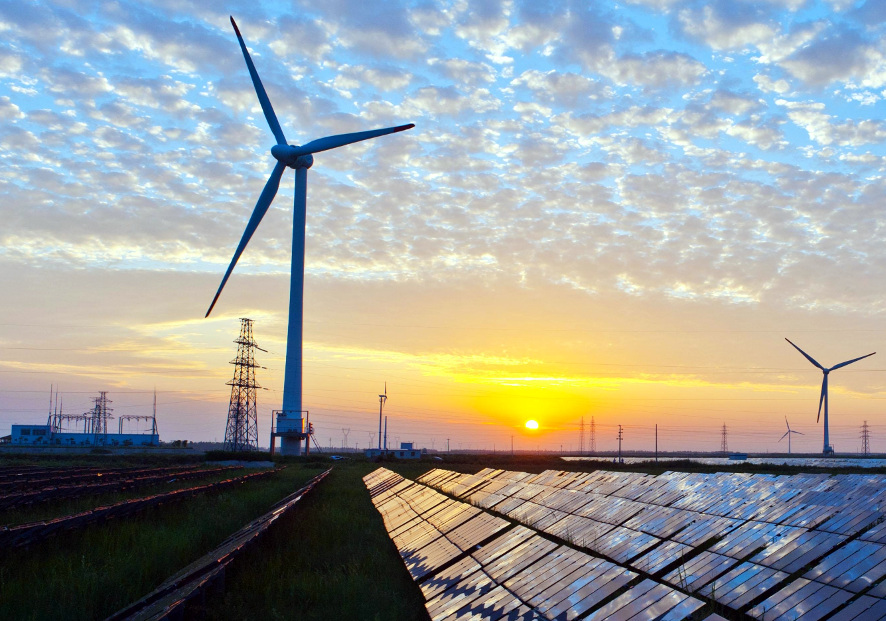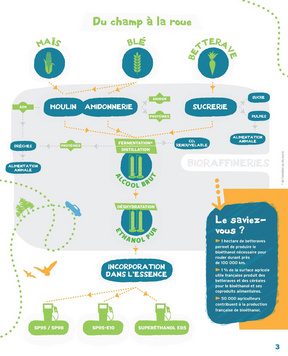 Wood energy, methanisation, solar, wind ...
Wood energy, methanisation, solar, wind ...

Historically, the role of agriculture has been to produce a permanent source of food for sedentary populations, but other functions have been added to this sector of activity over the last few centuries and decades.
These include maintaining the landscape, preserving the land, rural employment and biodiversity as indirect objectives of agriculture. More recently, the concepts of ecosystem services and energy production have been added to these secondary missions.
Over the last decade, French agriculture has accounted for less than 3% of national energy consumptionAgence[1] but nevertheless has some capacity to produce renewable energy. Indeed, it is estimated that the agricultural sector contributes 20% of renewable energy production in France, and that this figure is set to rise in the years aheadJ-L.[2]
This portal, which acts as a "preface" to the articles on the subject, covers the potential of agriculture for energy productionand the various technologies that can be envisaged in this sector.
Themes
Installation of a methanizer for gas production
Installation of solar panels on the ground to produce electricity
Biomass recovery
In agriculture, some of the biomass produced can be converted into energy, either from by-products such as crop residues, intermediate crops, etc., or from the production of biomass. intermediate crops ( or from dedicated crops.
Methanisation
Agricultural methanisation is one of the most frequently mentioned solutions for recovering energy from biomass, due to the many debates it has sparked over its environmental risks and its competition for farmland with livestock farming.

The principle is as follows: Organic organic matter (biomass) is partially digested by bacteria under anaerobic conditions (absence of oxygen) via a biological process, leading to the formation of biogas (composed of 55 to 70% methane) and digestate ("leftovers" of stabilised organic matter, concentrated in fertilising elements)[3] The gas generated is then refined to be injected into the supply network, or used to generate electricity; the digestate is generally returned to agricultural plots, which in a way helps to develop localself-sufficiency in nitrogen fertilisers.
The organic matter fed into the anaerobic digestion plant is generally made up of livestock manure, but sometimes also dedicated crops or intermediate crops for energy recovery (CIVE).
Wood energy

Whether it's hedgerows, riverbanks, forests, isolated trees or rows of trees in open fields, agriculture has many woody resources that can be used for wood energy. With the right species and the right tools, the upkeep of these agroforestry systems can produce logs and wood chips (after chipping) for energy purposes. These can be consumed on the farm, sold as secondary production, or fed into collective projects such as local authority heating systems.
Bioethanol
Bioethanol is a liquid biofuel, considered to be renewable: its production process is much shorter than that of fossil fuels. It is produced mainly from beetroot and cereals, whose sugar and starch are fermented by bacteria, then distilled into crude alcohol and incorporated into petrol before being consumed. Here again, the raw materials can come from the by-products of various industries (livestock feed in particular) or from dedicated crops.

Solar energy

Photovoltaics
Agriculture is also increasingly associated with electricity production through agrivoltaics, which by 2020 will account for 13% of the renewable energy produced by French agriculture[2].
Photovoltaics is a technology for producing electricity from solar radiation: an infinite resource. The sun's rays are captured by a power station or "panels", whose semiconductor crystals (generally silicon) enable the production of a direct current. The electricity produced in this way can be consumed locally or sold to a supplier.
In agriculture, photovoltaic production is usually reserved for non-productive surfaces that receive good sunlight, such as the roofs of buildings. But it can sometimes be the result of a compromise with cultivated areas, as in the case of photovoltaic farms in the field.

Thermal
Although less often mentioned, solar thermal energy is another way of harnessing the sun's rays for agricultural use. The technological principle is simpler: solar panels concentrate the heat received from the sun's rays in a network of pipes through which water circulates. The hot water can then be stored in a hermetically sealed tank and used to wash facilities, prepare food, heat a greenhouse or fish ponds, etc.
Wind power
Because of their topography, agricultural areas are often the most suitable for wind power production: over 80% of national wind power production takes place on agricultural landFrance[4] Wind power is used to generate electricity from the wind, which drives a propeller and spins a turbine to generate alternating current.
While large-scale wind turbines are rarely well accepted locally, because of their impact on the landscape, biodiversity and potentially on health, installing a domestic wind turbine can provide energy self-sufficiency as well as an additional source of income.

In a nutshell
Agriculture has already been called upon to address a wide range of social issues, and is now set to play a major role in the energy transition in Western countries. The diversity of energy production methods and the recent boom in certain technologies offer a multitude of solutions to be developed. These opportunities need to be well thought out and beneficial to farmers, without undermining the primary objective of the profession: to produce sufficient quality food resources. Below are practical guides and feedback from platform users on the issue of energy production.
References
- ↑ De l'Environnement et de la Maîtrise de l'Energie (ADEME), Production agricole : chiffres clés et observations, 2013. Consulted online in January 2022. https://www.ademe.fr/expertises/produire-autrement/production-agricole/chiffres-cles-observations,
- ↑ 2.0 2.1 Fugit (MP), R. Courteau (Senator), Rapport d'information : L'agriculture face au défi de la production d'énergie, Office parlementaire d'évaluation des choix scientifiques et technologiques, Rapport Assemblée nationale n°3220 (15ème législature) - Rapport Sénat n°646 (2019-2020). http://www.senat.fr/fileadmin/Fichiers/Images/redaction_multimedia/2020/2020-Documents_pdf/20200721_OPECST_synthese_rapport_agriculture_production_energie.pdf.
- ↑ INRAE, Press release - Bilan environnemental de la méthanisation agricole : une étude ACV inédite, 2021. https://www.inrae.fr/actualites/bilan-environnemental-methanisation-agricole-etude-acv-inedite.
- ↑ Énergie Éolienne, L'agriculture : vecteur de développement des énergies renouvelables, 2020. https://fee.asso.fr/actu/lagriculture-vecteur-de-developpement-des-energies-renouvelables/.